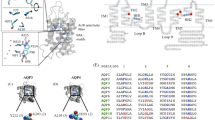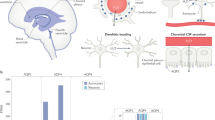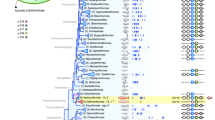Abstract
Water channels facilitate the rapid transport of water across cell membranes in response to osmotic gradients. These channels are believed to be involved in many physiological processes that include renal water conservation, neuro-homeostasis, digestion, regulation of body temperature and reproduction. Members of the water channel superfamily have been found in a range of cell types from bacteria to human. In mammals, there are currently 10 families of water channels, referred to as aquaporins (AQP): AQP0–AQP9. Here we report the structure of the aquaporin 1 (AQP1) water channel to 2.2 Å resolution. The channel consists of three topological elements, an extracellular and a cytoplasmic vestibule connected by an extended narrow pore or selectivity filter. Within the selectivity filter, four bound waters are localized along three hydrophilic nodes, which punctuate an otherwise extremely hydrophobic pore segment. This unusual combination of a long hydrophobic pore and a minimal number of solute binding sites facilitates rapid water transport. Residues of the constriction region, in particular histidine 182, which is conserved among all known water-specific channels, are critical in establishing water specificity. Our analysis of the AQP1 pore also indicates that the transport of protons through this channel is highly energetically unfavourable.
This is a preview of subscription content, access via your institution
Access options
Subscribe to this journal
Receive 51 print issues and online access
$199.00 per year
only $3.90 per issue
Buy this article
- Purchase on Springer Link
- Instant access to full article PDF
Prices may be subject to local taxes which are calculated during checkout





Similar content being viewed by others
References
Ishibashi, K. et al. Cloning and functional expression of a new aquaporin (AQP9) abundantly expressed in the peripheral leukocytes permeable to water and urea, but not to glycerol. Biochem. Biophys. Res. Commun. 244, 268–274 (1998).
Borgnia, M. et al. Cellular and molecular biology of the aquaporin water channels. Annu. Rev. Biochem. 68, 425–458 (1999).
Meinild, A. K. et al. Bidirectional water fluxes and specificity for small hydrophilic molecules in aquaporins 0–5. J. Biol. Chem. 273, 32446–32451 (1998).
Verkman, A. S. Water channels in cell membranes. Annu. Rev. Physiol. 54, 97–108 (1992).
Agre, P. et al. Aquaporin CHIP: the archetypal molecular water channel. Am. J. Physiol. 265, F463–F476 (1993).
Denker, B. M. et al. Identification, purification, and partial characterization of a novel Mr 28,000 integral membrane protein from erythrocytes and renal tubules. J. Biol. Chem. 263, 15634–15642 (1988).
Zeidel, M. L. et al. Ultrastructure, pharmacologic inhibition, and transport selectivity of aquaporin channel-forming integral protein in proteoliposomes. Biochemistry 33, 1606–1615 (1994).
Jap, B. K. & Li, H.-L. Structure of osmo-regulated H2O channel, AQP-CHIP, in projection at 3.5 Å resolution. J. Mol. Biol. 251, 413–420 (1995).
Li, H.-L., Lee, S. & Jap, B. K. Molecular design of aquaporin-1 water channel as revealed by electron crystallography. Nature Struct. Biol. 4, 263–265 (1997).
Cheng, A. et al. Three-dimensional organization of a human water channel. Nature 387, 627–630 (1997).
Walz, T. et al. The three-dimensional structure of aquaporin-1. Nature 387, 624–627 (1997).
Ren, G. et al. Three-dimensional fold of the human AQP1 water channel determined at 4 Å resolution by electron crystallography of two-dimensional crystals embedded in ice. J. Mol. Biol. 301, 369–387 (2000).
Murata, K. et al. Structural determinants of water permeation through aquaporin-1. Nature 407, 599–605 (2000).
Ren, G. et al. Visualization of a water-selective pore by electron crystallography in vitreous ice. Proc. Natl Acad. Sci. USA 98, 1398–1403 (2001).
Fu, D. et al. Structure of a glycerol-conducting channel and the basis for its selectivity. Science 290, 481–486 (2000).
Smith, B. L. & Agre, P. Erythrocyte Mr 28,000 transmembrane protein exists as a multisubunit oligomer similar to channel proteins. J. Biol. Chem. 266, 6407–6415 (1991).
Nielsen, S. et al. Distribution of the aquaporin CHIP in secretory and resorptive epithelia and capillary endothelia. Proc. Natl Acad. Sci. USA 90, 7275–7279 (1993).
Weiner, S. J. et al. A new force field for molecular mechanical simulation of nucleic acids and proteins. J. Am. Chem. Soc. 106, 765–784 (1984).
Doyle, D. A. et al. The structure of the potassium channel: molecular basis of K+ conduction and selectivity. Science 280, 69–77 (1998).
Park, J. H. & Saier, M. H. Jr Phylogenetic characterization of the MIP family of transmembrane channel proteins. J. Membr. Biol. 153, 171–180 (1996).
Zeuthen, T. & Klaerke, D. A. Transport of water and glycerol in aquaporin 3 is gated by H+. J. Biol. Chem. 274, 21631–21636 (1999).
Borgnia, M. J. & Agre, P. Reconstitution and functional comparison of purified GlpF and AqpZ, the glycerol and water channels from Escherichia coli. Proc. Natl Acad. Sci. USA 98, 2888–2893 (2001).
Baciou, L. & Michel, H. Interruption of the water chain in the reaction center from Rhodobacter sphaeroides reduces the rates of the proton uptake and of the second electron transfer to QB. Biochemistry 34, 7967–7972 (1995).
Ponamarev, M. V. & Cramer, W. A. Perturbation of the internal water chain in cytochrome f of oxygenic photosynthesis: loss of the concerted reduction of cytochromes f and b6. Biochemistry 37, 17199–17208 (1998).
Agmon, N. The Grotthuss mechanism. Chem. Phys. Lett. 224, 456–462 (1995).
Pomés, R. & Roux, B. Free energy profiles for H+ conduction along hydrogen-bonded chains of water molecules. Biophys. J. 75, 33–40 (1998).
Sui, H. et al. Crystallization and preliminary X-ray crystallographic analysis of water channel AQP1. Acta Crystallogr. D 56, 1198–1200 (2000).
Otwinowski, Z. & Minor, W. Processing of X-ray diffraction data collected in oscillation mode. Methods Enzymol. 276, 307–326 (1997).
de La Fortelle, E. & Bricogne, G. Maximum-likelihood heavy-atom parameter refinement for the multiple isomorphous replacement and multiwavelength anomalous diffraction methods. Methods Enzymol. 276, 472–494 (1997).
Cowtan, K. D. An automated procedure for phase improvement by density modification. Joint CCP4 ESF-EACBM Newsletter. Protein Crystallogr. 31, 34–38 (1994).
Jones, T. A. et al. Improved methods for building protein models in electron density maps and the location of errors in these models. Acta Crystallogr. A 47, 110–119 (1991).
Brünger, A. T. et al. Crystallography & NMR system: A new software suite for macromolecular structure determination. Acta Crystallogr. D 54, 905–921 (1998).
Chang, G. et al. Structure of the MscL homolog from Mycobacterium tuberculosis: a gated mechanosensitive ion channel. Science 282, 2220–2226 (1998).
Groll, M. et al. The catalytic sites of 20S proteasomes and their role in subunit maturation: a mutational and crystallographic study. Proc. Natl Acad. Sci. USA 96, 10976–10983 (1999).
Thompson, J. D. et al. CLUSTAL W: improving the sensitivity of progressive multiple sequence alignment through sequence weighting, position-specific gap penalties and weight matrix choice. Nucleic Acids Res. 22, 4673–4680 (1994).
Kraulis, P. J. MOLSCRIPT: a program to produce both detailed and schematic plots of protein structures. J. Appl. Crystallogr. 24, 946–950 (1991).
Merritt, E. A. & Bacon, D. J. Raster3D: Photorealistic molecular graphics. Methods Enzymol. 277, 505–524 (1997).
Smart, O. S. et al. The pore dimensions of gramicidin A. Biophys. J. 65, 2455–2460 (1993).
Kyte, J. & Doolittle, R. F. A simple method for displaying the hydropathic character of a protein. J. Mol. Biol. 157, 105–132 (1982).
Acknowledgements
Preliminary data collection and screening for heavy-atom derivatives were conducted at beamlines X25 at the National Synchrotron Light Source and 1–5 at Stanford Synchrotron Radiation Laboratory; data sets used in determining the model were collected at Beamline 5.0.2, Advanced Light Source, Lawrence Berkeley National Laboratory. We would like to thank all staff members of these beamlines for their assistance and B.-C. Wang for discussions on heavy-atom position refinement. This work is supported by funding from the National Institutes of Health and by the Office of Health and Environmental Research, US Department of Energy. The coordinates have been deposited in the Protein Data Bank under accession number 1J4N.
Author information
Authors and Affiliations
Corresponding authors
Ethics declarations
Competing interests
The authors declare no competing financial interests.
Rights and permissions
About this article
Cite this article
Sui, H., Han, BG., Lee, J. et al. Structural basis of water-specific transport through the AQP1 water channel. Nature 414, 872–878 (2001). https://doi.org/10.1038/414872a
Received:
Accepted:
Issue Date:
DOI: https://doi.org/10.1038/414872a
This article is cited by
-
Solar-driven membrane separation for direct lithium extraction from artificial salt-lake brine
Nature Communications (2024)
-
Aquaporin 1 overexpression may enhance glioma tumorigenesis by interacting with the transcriptional regulation networks of Foxo4, Maz, and E2F families
Chinese Neurosurgical Journal (2023)
-
Aromatic pentaamide macrocycles bind anions with high affinity for transport across biomembranes
Nature Chemistry (2023)
-
Two-dimensional non-linear hydrodynamics and nanofluidics
Communications Physics (2023)
-
Aquaporin water channels: roles beyond renal water handling
Nature Reviews Nephrology (2023)
Comments
By submitting a comment you agree to abide by our Terms and Community Guidelines. If you find something abusive or that does not comply with our terms or guidelines please flag it as inappropriate.



